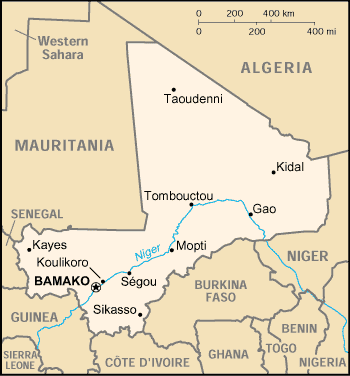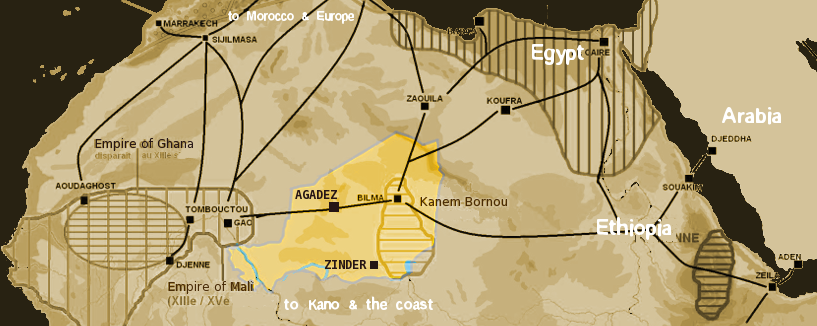Gao-Saney on:
[Wikipedia]
[Google]
[Amazon]
 Gao-Saney, also spelled Gao-Sane, is an archaeological site near
Gao-Saney, also spelled Gao-Sane, is an archaeological site near
 Additionally, salt was noted as a large part of the king's treasure at Gao. Supposedly, Gao controlled an underground salt mine, however, salt is archaeologically invisible.
The number of imports exploded with the penetration of Islam into West Africa. During the late eight century CE,
Additionally, salt was noted as a large part of the king's treasure at Gao. Supposedly, Gao controlled an underground salt mine, however, salt is archaeologically invisible.
The number of imports exploded with the penetration of Islam into West Africa. During the late eight century CE,
 Gao-Saney became well known among African historians when French administrators in 1939 discovered, in a cave covered with sand, several finely carved marble stelae produced in Almeria in Southern Spain. Their inscriptions attest to three kings of a Muslim dynasty bearing as loan names the names of
Gao-Saney became well known among African historians when French administrators in 1939 discovered, in a cave covered with sand, several finely carved marble stelae produced in Almeria in Southern Spain. Their inscriptions attest to three kings of a Muslim dynasty bearing as loan names the names of
 Gao-Saney, also spelled Gao-Sane, is an archaeological site near
Gao-Saney, also spelled Gao-Sane, is an archaeological site near Gao
Gao (or Gawgaw/Kawkaw) is a city in Mali and the capital of the Gao Region. The city is located on the River Niger, east-southeast of Timbuktu on the left bank at the junction with the Tilemsi valley.
For much of its history Gao was an imp ...
in Mali
Mali, officially the Republic of Mali, is a landlocked country in West Africa. It is the List of African countries by area, eighth-largest country in Africa, with an area of over . The country is bordered to the north by Algeria, to the east b ...
. It was almost certainly the town known in historical accounts as Sarneh.
Gao-Saney is a large settlement mound seven km distant from the royal town of Gao, and is thought to be the site of the ancient trading center. The site has produced extensive archaeological evidence from its first millennium occupation, with proposed chronology between 700 and 1100 CE. In modern day, the Gao region is too dry to sustain year-round habitation without digging deep wells, leading to speculation about different climate conditions, perhaps with increased rainfall, at the time of Gao's first millennium occupation.
Gao-Saney excavations demonstrate involvement of the site in glass and copper trade networks during the eighth to tenth centuries on a scale only exceeded by Igbo-Ukwu
Igbo-Ukwu ( English: ''Great Igbo'') is a town in the Nigerian state of Anambra in the south-central part of the country. The town comprises three quarters namely Obiuno, Ngo, and Ihite (an agglomeration of 4 quarters) with several villages wi ...
among known sub-Saharan sites.
History
Archaeological digs show that Gao-Saney was occupied by roughly 700CE, and was a center of manufacturing, iron smelting, and trade with areas as far away asMesopotamia
Mesopotamia is a historical region of West Asia situated within the Tigris–Euphrates river system, in the northern part of the Fertile Crescent. Today, Mesopotamia is known as present-day Iraq and forms the eastern geographic boundary of ...
. It was the southern terminus of a trade route powered by chariots that linked it to the Mediterranean. At some point no later than the early 10th century the Songhay king moved to the site of Gao Ancien, just north of the modern city on the bank of the Niger river
The Niger River ( ; ) is the main river of West Africa, extending about . Its drainage basin is in area. Its source is in the Guinea Highlands in south-eastern Guinea near the Sierra Leone border. It runs in a crescent shape through Mali, Nige ...
and a few kilometers from Gao Saney. The kings of this period were of a lineage known as Qanda.
Arabic sources from the 9th to 11th centuries frequently describe Gao as consisting of two towns. al-Idrisi
Abu Abdullah Muhammad al-Idrisi al-Qurtubi al-Hasani as-Sabti, or simply al-Idrisi (; ; 1100–1165), was an Arab Muslim geographer and cartographer who served in the court of King Roger II at Palermo, Sicily. Muhammad al-Idrisi was born in C ...
, writing in around 1154, does not mention a second town, and archaeological excavations in Gao-Saney indicate the site may have beena abandoned by this time.
Subsistence Economy & Production
Livestock
Gao Saney had a mixed millet, caprine, and cattle based subsitence economy. Goats and sheep were very populous, significantly outnumbering cattle, while camels appear only sometimes in the faunal assemblage, and were likely consumed and used for transport.Copper
809 copper-based artifacts have been found, with almost half of them shaped as copper crescents. Given their consistent shape, it has been hypothesized that the copper crescents were used as currency, however, most of the copper artifacts found have been fragments, making it difficult to test this hypothesis.Glass
Glass processing was among the earliest activities that took place. Thousands of glass beads have been found in and around Gao, dating from the eighth to the fourteenth century CE.McIntosh, S. K., Wood, M., Dussubieux, L., Robertshaw, P., Insoll, T., & Cissé, M. (2020). Glass Beads from Medieval Gao (Mali): New Analytical Data on Chronology, Sources, and Trade, ''Journal of African Archaeology'', ''18''(2), 139-161. Their shapes include cylinder, oblate, sphere, tube, ellipsoid, bicone, and disc, and colors range from red to blue to yellow. Analyzing the composition of the beads can indicate their origins; several compositional groupings have been recognized, included plant-ash soda-lime-silica glass, mineral soda-lime-silica glass, high-lime high-alumina glass, mineral soda-high alumina glass, plant ash soda-high alumina glass and a high lead composition glass. The dating of these different composites indicates that the source of the glass used to make the beads changed sometime during the end of the tenth century. Earlier glasses were probably produced in Iraq and Baghdad, and later glasses were produced in Egypt.Trade
Gao Saney participated in regional and long-distance trade, indicated by extensive glass compositions sourced in the Middle East, and non-local items such as carnelian, flint, and granite grinding stones. Understanding how trade networks developed over time will require further research. However, at the moment, data indicates that the region surrounding Gao was involved in trade networks that moved imported glass and copper from distant sources, beginning by 400 CE. Excavations at Gao Saney show its involvement in the trade networks in the eighth through tenth centuries on a scale only exceeded by Igbo Ukwu among known sub-Saharan sites.Ibadi
Ibadism (, ) is a school of Islam concentrated in Oman established from within the Kharijites. The followers of the Ibadi sect are known as the Ibadis or, as they call themselves, The People of Truth and Integrity ().
Ibadism emerged around 6 ...
Sharia
Sharia, Sharī'ah, Shari'a, or Shariah () is a body of religious law that forms a part of the Islamic tradition based on Islamic holy books, scriptures of Islam, particularly the Quran, Qur'an and hadith. In Islamic terminology ''sharīʿah'' ...
law contributed to increased efficiency, trust, financing, and security within more expansive trade networks."
Material Culture
The earliest material culture at Gao-Saney, including its pottery, suggest Songhai-Berber
Berber or Berbers may refer to:
Ethnic group
* Berbers, an ethnic group native to Northern Africa
* Berber languages, a family of Afro-Asiatic languages
Places
* Berber, Sudan, a town on the Nile
People with the surname
* Ady Berber (1913–196 ...
presence rather than Arabic. Historical evidence indicates that the king of Gao converted to Islam during the 10th century. Archaeologically, the cemetery stelae
A stele ( ) or stela ( )The plural in English is sometimes stelai ( ) based on direct transliteration of the Greek, sometimes stelae or stelæ ( ) based on the inflection of Greek nouns in Latin, and sometimes anglicized to steles ( ) or stela ...
are the main evidence for Islam at Gao.
Pottery
An excavation of 5700 rim and body sherds showed Gao Saney's ceramic assemblage to be largely homogeneous throughout all the deposits. Most of the vessels were organic-tempered jars with long funnel-like rims decorated with broad channels, typically painted with a combination of white, black, and red paint. There were also small simple-rim bowls decorated with impressed comb in linear or geometric patterns. The presence of very similar pottery assemblages near places likeTimbuktu
Timbuktu ( ; ; Koyra Chiini: ; ) is an ancient city in Mali, situated north of the Niger River. It is the capital of the Tombouctou Region, one of the eight administrative regions of Mali, having a population of 32,460 in the 2018 census.
...
, Gourma Rharous, and Bentia indicate river-based cultural interaction along the Middle Niger.
Stelae
 Gao-Saney became well known among African historians when French administrators in 1939 discovered, in a cave covered with sand, several finely carved marble stelae produced in Almeria in Southern Spain. Their inscriptions attest to three kings of a Muslim dynasty bearing as loan names the names of
Gao-Saney became well known among African historians when French administrators in 1939 discovered, in a cave covered with sand, several finely carved marble stelae produced in Almeria in Southern Spain. Their inscriptions attest to three kings of a Muslim dynasty bearing as loan names the names of Muhammad
Muhammad (8 June 632 CE) was an Arab religious and political leader and the founder of Islam. Muhammad in Islam, According to Islam, he was a prophet who was divinely inspired to preach and confirm the tawhid, monotheistic teachings of A ...
and his two successors. From the dates of their deaths it appears that these kings of Gao ruled at the end of the twelfth and the beginning of the thirteenth centuries CE, and represent a transition in leadership.
Historian Dierk Lange has argued that the ''Zaghe'' kings commemorated by the stelae, so-called because of multiple references to an ancestor of that name, are identical with some of the kings of the Za dynasty listed by the chroniclers of Timbuktu
Timbuktu ( ; ; Koyra Chiini: ; ) is an ancient city in Mali, situated north of the Niger River. It is the capital of the Tombouctou Region, one of the eight administrative regions of Mali, having a population of 32,460 in the 2018 census.
...
in the Ta'rikh al-Sudan and Ta'rikh al-Fattash. Their Islamic loan names are in one instance complemented by a local name, which has allowed the identification. Historians such as John Hunwick, however, have rejected this interpretation.
See also
* Gao Empire * Songhay EmpireReferences
Sources
*. *. *. *. First published in 1981 by Cambridge University Press, . * {{coord, 16, 15, 03, N, 0, 00, 11, W, region:ML-7_type:city_source:kolossus-dewiki, display=title Gao Empire History of Gao Archaeological sites of Western Africa